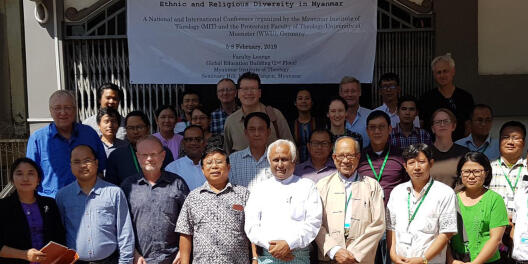Religion and Politics in Myanmar
Conference on the tensions of ethnic and religious diversity in Yangon, Myanmar

Within the context of the project “Religiöser Pluralismus im Diskurs – Buddhisten und Christen in Myanmar und ihr Umgang mit religiöser Pluralität” (Religious pluralism in discourse – Buddhists and Christians in Myanmar coping with religious plurality), led by scholars of the Cluster of Excellence, a conference on ethnic and religious diversity in Myanmar was held in Yangon (formerly: “Rangun”) from 5 to 8 February. The project, which is funded by the German Research Foundation (DFG), has been in its two-year extension phase since 2018 and is being carried out in cooperation with the Myanmar Institute of Theology (MIT), Yangon.
The Protestant theologian Prof. Dr. Hans-Peter Großhans and the scholar of religious studies and theologian Prof. Dr. Perry Schmidt-Leukel from the Cluster of Excellence discussed the tension-laden connections between ethnic and religious diversity with internationally renowned experts from Thailand, India, Australia, the USA, Denmark and Estonia as well as eight international and national scientists working in different parts of Myanmar. The conference was conceptualised and organised by the scholar of religious studies Dr. Madlen Krüger, who works at the University of Münster and carries out field research in Myanmar as part of the project.
Ethnic diversity from a religious perspective
Myanmar, the country between Thailand and India known as “Burma” or “Birma” under British colonial rule, has made the headlines in recent years, particularly due to the violent events surrounding the Muslim ethnic group from the Rakhine region known as “Rohingya”. The problems resulting from the tension between ethnic and religious diversity, however, reach much farther and are much more complicated. Up to 135 ethnic groups exist in Myanmar, some of which have very different religious affiliations, even though the country as a whole is dominated by Buddhism, which accounts for about 88% of the population.
The conference looked at the tension between national identity and ethnic diversity from the perspective of the three largest religious communities in Myanmar: Buddhism, Christianity and Islam. The focus was on the historical development of Myanmar and its current national self-image (and the critical assessment of the latter from the point of view of ethnic and religious minorities), the various constitutive elements of ethnic and religious identities, and the search for political and religious strategies for resolving conflicts in the current transition from a centralist military dictatorship to a democratic federal union of the peoples of Myanmar. Individual case analyses, e.g. with regard to the Chin, Kachin, Karen, Shan and to Muslim ethnic groups (such as the Rohingya), were partly supplemented by comparative perspectives on other countries. (exc)

